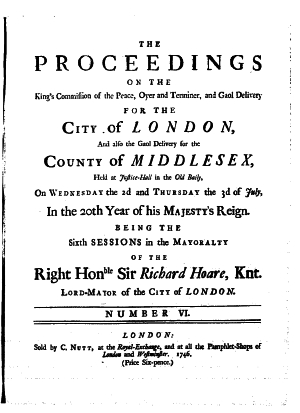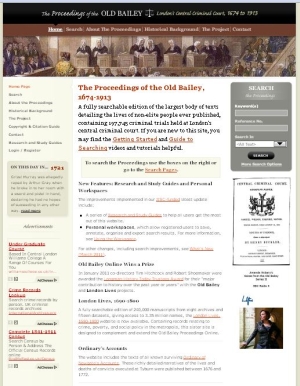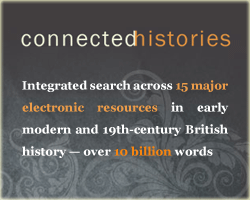
Old Bailey Proceedings Online
Introduction
Originally published as printed periodical, these published accounts of eighteenth-century criminal trials include frequent, but not consistent, information about the place of residence of the accused and the location of the crime. In the process of creating the online edition of the Proceedings this information was marked up as person locations and crime locations to enable structured searching. Locating London's Past makes it possible, for the period from 1674 to 1820, to display and tabulate these locations on maps of London according to specified criteria.
The Proceedings as an Historical Source
The Proceedings contain accounts of trials which took place at the Old Bailey, London's only criminal court for trials of serious crimes (felonies). The first published collection of trials at the Old Bailey dates from 1674, and from 1678 accounts of the trials at each sessions (meeting of the Court) were regularly published. Inexpensive, and targeted initially at a popular audience, the Proceedings were produced shortly after the conclusion of each sessions and were initially a commercial success. But with the growth of newspapers and increasing publication costs the audience narrowed by the nineteenth century to a combination of lawyers and public officials. Although a commercial publication, the Proceedings were published under licence from the City of London, which made some attempt to regulate their content. For more information, see The Publishing History of the Proceeidngs.
There are significant limitations in terms of the information provided in the Proceedings. First, it is important to note that editions only survive for approximately half of the sessions between 1674 and 1714; from 1715 onwards coverage is full. Second, while virtually all trials were included, the Proceedings do not provide transcripts of everything that was said in court; even where an account looks complete, the reporting is likely to have been selective. While early accounts are often no more than brief summaries, verbatim testimonies were commonly included from the 1720s. But even in the 1780s, when the Proceedings appear to have been at their most comprehensive, much material was still left out. Particularly likely to have been omitted, or tersely summarised, are legal arguments, defence testimonies, and the judge's summing up. For more information, see The Value of the Proceedings as a Historical Source.
Geographical Information in the Proceedings
![The progress of a rake, exemplified in the Adventures of Ramble Gripe Esq son of Sir Positive Gripe / Going to court he's arrested at St. James's Gate (1735)]]. © Trustees of the British Museum. The progress of a rake, exemplified in the Adventures of Ramble Gripe Esq son of Sir Positive Gripe / Going to court he's arrested at St. James's Gate (1735)]]. © Trustees of the British Museum.](images/Arrest.jpg) The progress of a rake, exemplified in the Adventures of
Ramble Gripe Esq son of Sir Positive Gripe / Going to court
he's arrested at St. James's Gate (1735). © Trustees of the British Museum..
The progress of a rake, exemplified in the Adventures of
Ramble Gripe Esq son of Sir Positive Gripe / Going to court
he's arrested at St. James's Gate (1735). © Trustees of the British Museum..
The Proceedings were under no obligation to include evidence about where the defendant was from, or where the crime took place. This information was provided according to the whim of the publisher, and is provided in approximately xx per cent of the trials. These details may well have been read out from the parchment indictment at the start of the trial by the clerk, and noted down by the shorthand writer whose notes form the basis of the Proceedings. This information was a legal requirement for an indictment to be valid, and if missing from the Proceedings can be found in the original indictments, kept at the London Metropolitan Archives.
The information should be treated with some scepticism. Analysis of indictments from other courts and counties has shown that the place identified as the defendant's residence is very frequently the place where the crime took place; clerks, conscious that the legal requirement was for some location to be identified as the defendant's home, not that such information be necessarily accurate, often appear to have simply assumed that it was the same as the crime location.1
 Title page of
The Proceedings of the Old Bailey, 2nd July 1746.
Title page of
The Proceedings of the Old Bailey, 2nd July 1746.
In the process of digitising the Proceedings, the Old Bailey Online project manually tagged place names as either defendant locations or crime locationss, where such information appears in the first two paragraphs of the trial. While this process captured the vast majority of relevant information, some incidental information which appears in the remainder of the accounts has been missed.
These marked up place names, which were highly variable in form, were then processed using the Geocoder to standardise them in order to enable them to be mapped.
Ordinary's Accounts
For information about the Ordinary's Accounts, the sister publication of the Proceedings, see the information page about the London Lives datasets.
Mapping the Old Bailey Proceedings
Using the Old Bailey Dataset search page?, you can specify...
Bibliography
- Simon Devereaux, 'The City and the Sessions Paper: 'Public Justice' in London, 1770-1800', Journal of British Studies 35 (1996), 466-503
- Simon Devereaux, 'The Fall of the Sessions Paper: Criminal Trial and the Popular Press in Late Eighteenth-Century London', Criminal Justice History 18 (2002), 57-88
- Clive Emsley, Tim Hitchcock and Robert Shoemaker, Publishing History of the Proceedings, Old Bailey Proceedings Online (www.oldbaileyonline.org)
- Clive Emsley, Tim Hitchcock and Robert Shoemaker, The Value of the Proceedings as a Historical Source, Old Bailey Proceedings Online (www.oldbaileyonline.org)
- Robert B. Shoemaker, 'The Old Bailey Proceedings and the Representation of Crime and Criminal Justice in Eighteenth-Century London', Journal of British Studies 47 (2008)
Footnotes
1 J. S. Cockburn, 'Early-modern assize records as historical evidence', Journal of the Society of Archivists 5 (1975), p. 225; R. B. Shoemaker, 'Using Quarter Sessions Records as Evidence for the Study of Crime and Criminal Justice', Archives 20 (October 1993), pp. 152-53. ⇑

